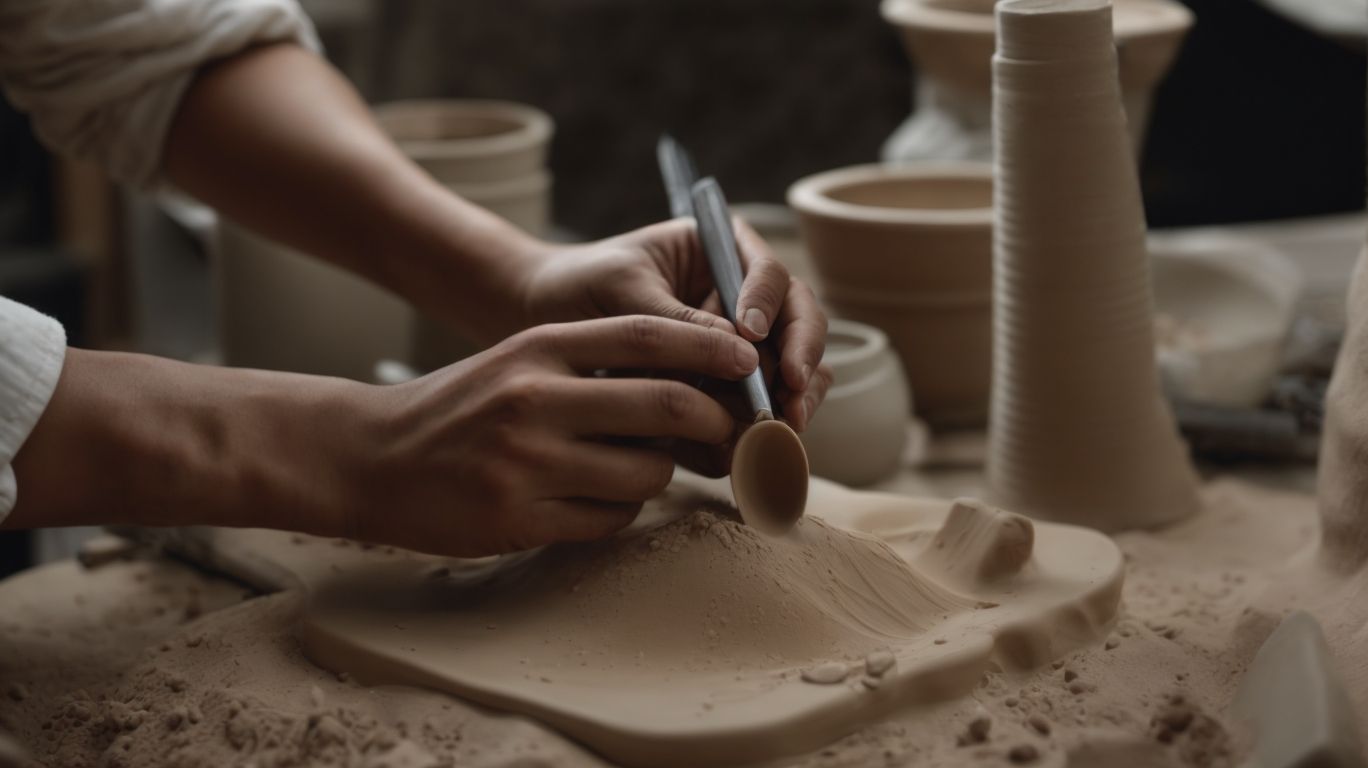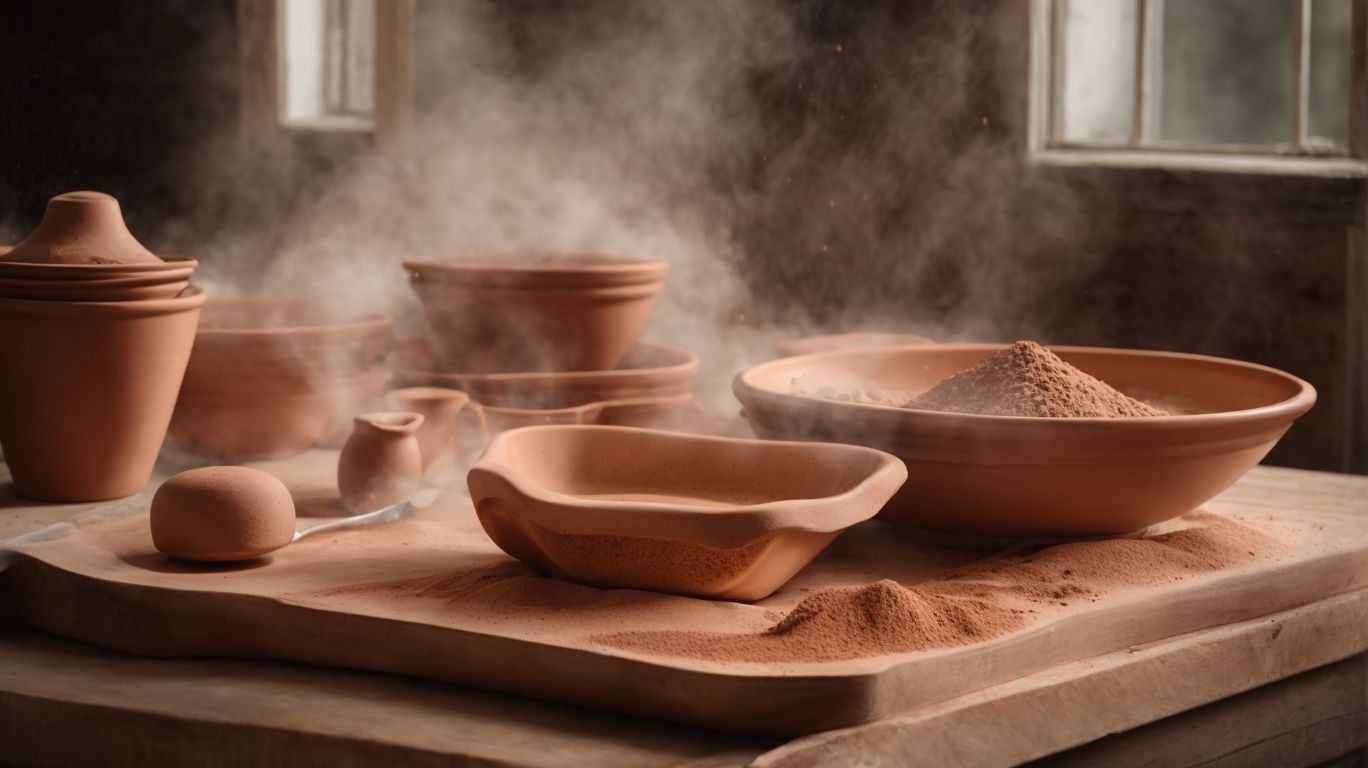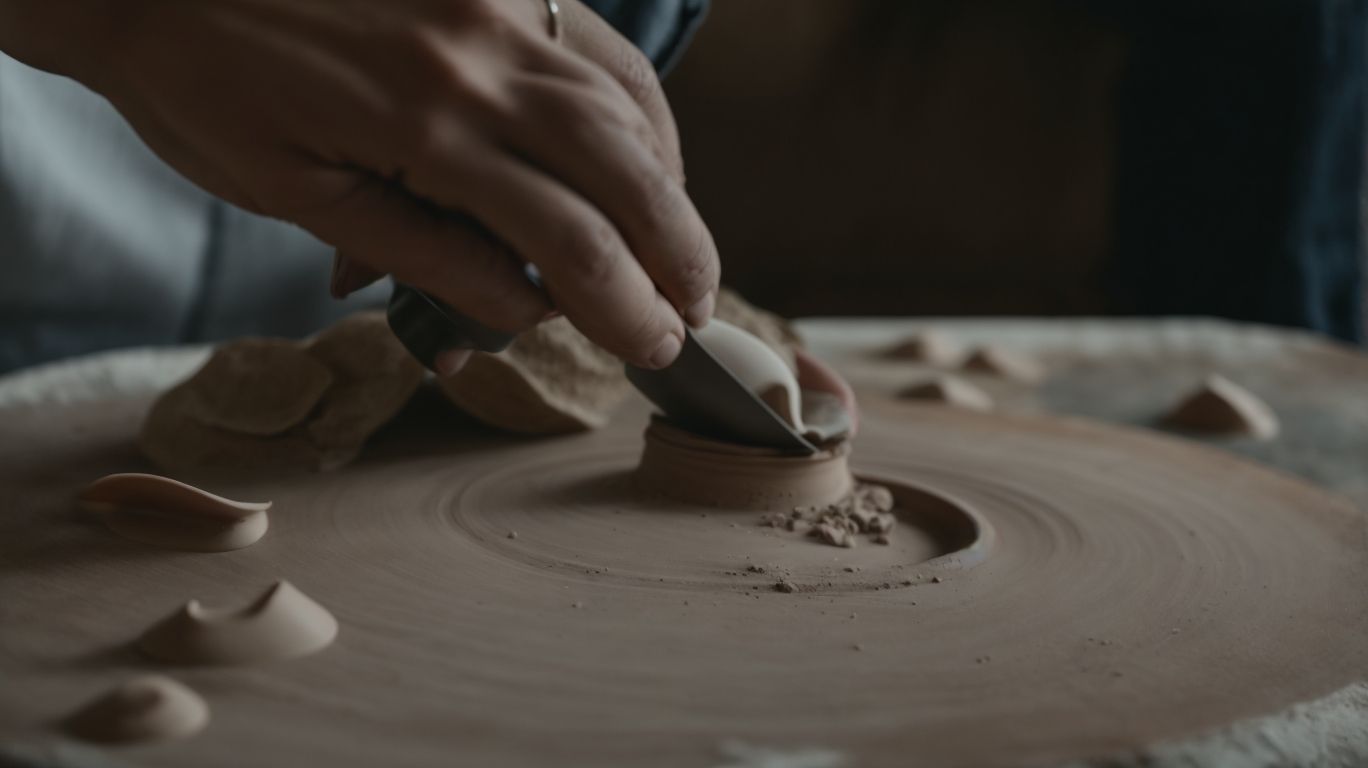How to Bake Clay Without a Kiln?
Curious about baking clay without a kiln? We will explore the world of clay and how it can be baked without the need for a traditional kiln.
From the different types of clay that can be used to the various methods for baking it, we will cover everything you need to know to successfully bake clay at home.
Whether you’re looking for a cost-effective option or simply want to try your hand at a new DIY project, baking clay without a kiln is not only possible but also easy!
Key Takeaways:
What is Clay and How Does it Bake?
Clay, a versatile material used in ceramics, undergoes a transformation through firing in a kiln, where it is baked at high temperatures to achieve its final form.
Clay, in its natural state, is pliable and moldable, making it ideal for shaping into various artistic and functional pieces. It is composed of fine particles of minerals and organic materials, lending it a unique texture and workability. During the firing process in a kiln, the clay undergoes physical and chemical changes; it loses its plasticity and water content, becoming more durable and stable.
What Types of Clay Can Be Baked Without a Kiln?
Earthenware ceramics and air dry clay are examples of clay that can be baked without the need for a kiln, offering accessible options for pottery enthusiasts.
Regarding air dry clay, it is a convenient choice for beginners and those without access to a kiln. This type of clay dries naturally when left exposed to the air, eliminating the need for high-temperature firing. Its pliability allows for easy sculpting, making it ideal for creating intricate designs. On the other hand, earthenware ceramics offer a more traditional approach, producing durable pieces suitable for everyday use. They require a low-temperature firing process which can be achieved through pottery studios equipped with electric kilns.
Why Would Someone Want to Bake Clay Without a Kiln?

Credits: Poormet.Com – Gregory Scott
Baking clay without a kiln appeals to individuals seeking cost-effective, convenient, and versatile ways to explore pottery making within their community or local resources.
Many pottery enthusiasts find traditional kilns expensive and space-consuming, so turning to alternative methods such as using a home oven or even a simple campfire allows them to unleash their creativity without breaking the bank.
Community centers and local pottery groups often offer workshops or classes focusing on kiln-free techniques, providing valuable hands-on experience while connecting with fellow artisans.
By embracing these accessible options, passionate crafters can develop their skills, experiment with different firing processes, and create unique pieces right in their own backyard.
Cost-Effective
Opting for methods to bake clay without a kiln can be cost-effective, especially for individuals engaging in frequent pottery firing activities or taking pottery courses that offer kiln rentals.
It’s essential to consider how alternative clay baking techniques not only help in reducing expenses but also provide flexibility in scheduling firing sessions. By using household items like a regular oven, a gas grill, or a DIY pit firing method, pottery enthusiasts can save on the costs associated with operating a traditional kiln.
For those involved in pottery courses or workshops where kiln rentals are available, opting for kiln-free baking methods can offer significant savings in the long run. This allows students to practice their craft without the added expense of kiln usage fees, making pottery more accessible and affordable for aspiring artisans.
Convenience
The convenience of baking clay without a kiln is evident for participants attending pottery firing classes, artists seeking art spaces, or members of online pottery communities like the Facebook Group Clay Buddies.
Non-kiln baking methods offer a practical solution for those who do not have access to traditional kilns, making it easier for beginners to delve into the art of pottery without expensive equipment limitations. This accessibility extends to various art spaces and studios that may not have kilns on-site, allowing artists to conveniently fire their creations without struggling with transportation or outsourcing services.
The rise of online pottery communities has created a virtual space for enthusiasts to share tips, techniques, and support each other in their ceramic endeavors, enhancing the overall pottery experience beyond physical boundaries.
Versatility
Exploring the versatility of baking clay without a kiln allows for creative endeavors such as crafting raku pieces, experimenting with primitive firing techniques, and engaging with the vibrant pottery community.
One of the fascinating aspects of creating raku pieces through non-kiln baking methods is the unpredictable yet captivating results that can be achieved. Artists find joy in the nuanced colors and striking patterns that emerge from the rapid cooling process, creating truly unique pieces.
Using primitive firing techniques like pit firing or sawdust firing adds an element of ancient mystique to the pottery-making process. The raw, earthy textures and smoky finishes obtained through these methods speak to the primal connection between artist and material.
Being part of the pottery community opens doors to collaborative projects, workshops, and exhibitions that foster creativity and camaraderie among artisans. Sharing ideas and techniques during group firings or pottery symposiums enhances one’s skills and broadens their artistic horizons.
How to Prepare Clay for Baking Without a Kiln?
Preparing clay for baking without a kiln involves selecting the right clay type and leveraging resources such as pottery studios, online platforms like KilnShare.com, or engaging with pottery/ceramic clubs for guidance.
Clay selection is crucial for successful non-kiln baking. Opt for air-dry clays, polymer clays, or cold porcelain that are formulated for this purpose. Utilizing pottery studios allows access to essential tools like clay rollers, molds, and glazes. KilnShare.com offers a platform to connect with local studios for renting kilns and firing services. Pottery/ceramic clubs provide a community of experienced potters who can offer valuable tips and support in your clay crafting journey.
Choosing the Right Clay
Selecting the right type of clay is essential for successful baking without a kiln, considering factors such as glazing compatibility, guidance from pottery courses, or the option to experiment with primitive kilns.
Regarding clay selection, one must take into account the specific firing method being employed. Different clays respond differently to various heat sources, making it crucial to choose a clay that suits your baking needs. Understanding the characteristics of the clay can offer valuable insights into its behavior during firing, allowing for better control over the final outcome. Pottery courses often emphasize the importance of matching clay types with suitable glazing techniques to achieve desired results.
Experimenting with traditional pottery techniques using primitive kilns can be a rewarding experience. By exploring these age-old methods, one can develop a deeper appreciation for the art of pottery and gain a greater understanding of the intricate process involved.
Preparing the Clay for Baking
Preparing the clay for baking without a kiln involves the expertise of ceramicists, the incorporation of cover sherds for protection, and the anticipation of creating unique pottery artwork through alternative firing methods.
Ceramicists meticulously select the clay, ensuring its ideal consistency and texture for hand-building or wheel-throwing. The clay is then kneaded and wedged to remove air bubbles, making it more pliable for shaping. Once the desired form is crafted, cover sherds, fragments of fired pottery, are strategically placed over the piece to shield it from direct heat during the firing process, preventing cracks and breakage.
Artists often experiment with various firing techniques like pit firing or Raku firing to achieve distinctive surface finishes and color effects. Through these unconventional methods, the pottery undergoes transformations, with unpredictable patterns and hues emerging, resulting in truly one-of-a-kind pieces that showcase the creativity and skill of the maker.
Methods for Baking Clay Without a Kiln

Credits: Poormet.Com – Christian Miller
Various methods such as outdoor firing processes, utilization of kiln furniture, and participation in events like the Southwest Kiln Conference offer avenues for baking clay without a traditional kiln, fostering creativity and exploration.
Outdoor firing processes involve techniques like pit firing, bonfire pottery, and raku firing which provide unique results and a connection with nature. Kiln furniture plays a crucial role in supporting clay pieces during alternative firing methods, ensuring even heat distribution and preventing warping or cracking. Events like the Southwest Kiln Conference bring together pottery enthusiasts and experts to share knowledge, demonstrate techniques, and inspire experimentation with unconventional pottery firing methods.
Using a Home Oven
Utilizing a home oven for baking clay presents a convenient option for enthusiasts associated with pottery groups, exploring diverse firing techniques, or working with earthenware compositions.
Regarding pottery activities, a home oven serves as a versatile tool for firing clay creations. Not only does it offer a cost-effective solution, but it also allows for experimentation with different firing temperatures and durations, enabling enthusiasts to achieve unique effects on their earthenware pieces.
Clay baking in a conventional oven is particularly popular among pottery communities due to its accessibility and ease of use. Whether creating functional pottery or decorative ceramics, the home oven method provides a reliable way to bring art to life.
Using a DIY Kiln
Creating a DIY kiln offers a customizable approach to baking clay, ideal for artists seeking solutions beyond traditional kilns or aiming to craft unique pottery artwork in their art studio.
DIY kilns are a versatile tool for those who appreciate getting hands-on with the creative process. With the surge of interest in primitive firing techniques, these homemade kilns have gained popularity among pottery enthusiasts exploring alternative methods. Artistic spaces benefit greatly from the adaptability of DIY kilns, enabling artists to experiment with different firing temperatures and atmospheric conditions.
Whether you’re a beginner honing your craft or a seasoned artisan looking to break free from conventional methods, a DIY kiln can be an essential asset in your creative journey.
Using a Campfire
Harnessing the heat of a campfire can be a communal and resourceful way to bake clay, fostering collaboration within the pottery community, leveraging expertise from ceramicists, and safeguarding pottery with cover sherds.
During these open-air firing processes, cover sherds are strategically placed above the pottery pieces to shield them from direct exposure to flames, ensuring a more even heat distribution and protecting the delicate surfaces of the ceramics.
This centuries-old method not only ensures the proper baking of clay but also creates a sense of unity among potters gathered around the flickering flames, sharing techniques, stories, and inspirations.
The act of working together to feed the fire, monitor the temperature, and anticipate the transformation of the clay pieces highlights the collaborative spirit engrained in the art of pottery making.
Tips for Successful Baking of Clay Without a Kiln
Achieving successful outcomes when baking clay without a kiln requires monitoring temperature and time diligently, utilizing thermometers for accuracy, and allowing adequate cooling time for pottery enthusiasts, pottery groups, or those engaging with kiln-sharing resources.
Temperature management is crucial in clay baking without a kiln. To ensure the best results, maintain a consistent temperature throughout the process. One practical tip is to preheat your conventional oven to around 200-250 °C before placing the clay items inside. Use a reliable thermometer to monitor the temperature accurately, adjusting as needed to keep it within the desired range.
As important as temperature is, time supervision is equally essential. Different types of clay require specific firing durations, so it’s essential to follow the recommendations provided with your clay or refer to pottery guides for guidance.
Monitor Temperature and Time
Vigilantly monitoring the temperature and time during clay baking is essential for individuals utilizing pottery studios, renting kilns, or experimenting with techniques like raku firing to achieve the desired results.
Proper temperature and time management play a crucial role in the outcome of clay pieces, impacting their structural integrity, color variations, and overall aesthetic appeal.
It is imperative to understand the specific requirements of the clay type being used, as different clays may necessitate varying firing schedules and peak temperatures.
For those engaging in raku firing, where the rapid cooling process is as critical as the firing itself, precise timing becomes even more paramount to achieve the distinctive crackled glaze effect.
Use a Thermometer
Employing a thermometer for accurate temperature control is recommended for individuals attending pottery courses, experimenting with primitive firing techniques, or working in art studios to enhance their clay baking precision.
Using a thermometer in the clay baking process, especially in the absence of a kiln, helps in achieving consistent results and ensuring that the clay reaches the desired temperature for proper firing. This tool allows artists and enthusiasts to monitor the heat levels during various stages of the firing process, such as preheating, oxidation, reduction, and cooling. By understanding the temperature variations within the kiln or alternative firing setups, participants can adjust their techniques accordingly to produce high-quality ceramic pieces with the desired characteristics.
Allow for Cooling Time
Incorporating adequate cooling time post-baking is crucial for members of the pottery community, users of kiln furniture, and creators of intricate pottery artwork, as it ensures the preservation of their crafted pieces.
Allowing sufficient cooling time post-baking can prevent sudden temperature changes that may lead to cracking or warping of the pottery, protecting the intricate details and structural integrity of the creations.
This cooling process, sometimes referred to as ‘annealing,’ is especially vital for individuals working with delicate clay that requires careful handling to avoid damage.
Artists invested in producing high-quality pottery pieces recognize the significance of patience during the cooling phase to avoid potential pitfalls that could jeopardize their artistic vision.
Conclusion: Baking Clay Without a Kiln is Possible and Easy!
The process of baking clay without a kiln opens up creative possibilities for pottery firing enthusiasts, artists seeking unconventional art spaces, and those looking to explore alternative methods in their artistic endeavors.
One key advantage of non-kiln clay baking methods is the accessibility they offer to individuals who may not have access to traditional kiln facilities. This allows enthusiasts to experiment with pottery firing in their own homes or studios, fostering a sense of independence and creativity.
For artists in search of unique art spaces, these alternative techniques provide a way to infuse their creations with a distinct touch. The ability to work with non-kiln clay baking methods opens the door to a realm of possibilities, where artists can push boundaries and create pieces that stand out in the art world.
Frequently Asked Questions
What are the different ways to bake clay without a kiln?
There are several methods for baking clay without a kiln, including using an oven or a gas stove, using a portable butane torch, or using an open fire pit.
How do I bake clay in a regular oven?
To bake clay in a regular oven, preheat the oven to the temperature recommended for your type of clay. Place the clay on a baking sheet or dish and bake for the recommended amount of time, usually around 20-30 minutes per 1/4 inch of thickness.
Can I use a gas stove to bake clay?
Yes, you can use a gas stove to bake clay. Simply follow the same steps as baking in a regular oven, but place the clay on a baking dish or inside a heat-safe container before placing it on the stove.
Is it safe to bake clay in a microwave?
No, it is not safe to bake clay in a microwave. Microwaves heat food by causing water molecules to vibrate, and since clay does not contain water, it will not heat evenly and may even cause a fire.
Can I bake clay outside in a fire pit?
Yes, you can bake clay in an open fire pit, but it may take longer than other methods. To do this, wrap the clay in foil and place it in the fire pit, ensuring the flames do not directly touch the clay.
Are there any safety precautions I should take when baking clay without a kiln?
Yes, there are a few safety precautions to keep in mind when baking clay without a kiln. Make sure to wear heat-resistant gloves when handling hot clay, use a heat-safe container when baking on a stove or in a fire pit, and always have a fire extinguisher nearby, just in case.

